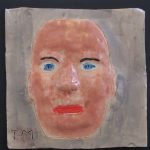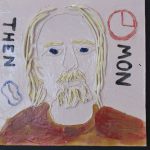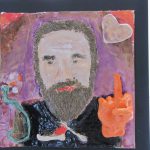The Face of Our Story

The Gardiner Museum of Ceramic Art, in partnership with the Toronto Community Hep C Program (TCHCP), invited people with lived experience of hepatitis C to take part in an art project called The Face of Our Story. In that project, clay tiles depicting stories of lived experience would be displayed at the museum on World Hepatitis Day, July 28, 2016. This is the story of Signe and Tom who participated in the event.
The day arrived when we met with museum staff, were given a tour, and the project was explained to us. We were nervous. We were proud to be part of this experience, but at the same time unsure of our surroundings and what was expected of us. None of us had ever put on an art show in a museum. We spoke in hushed tones and experienced a feeling of reverence as we saw the beautiful work of other artists. We exchanged glances and thought, “Uh oh! What are we doing here?”
We were a mixed group but what connected us was our involvement in the TCHCP. Most of us had used drugs in the past and some of us still did. We, as a community, were often passed over, regarded with disdain by the healthcare system. Many of us had waited decades to access hepatitis C treatment, and we did not want others to share that same fate. But the TCHCP had accepted us as we were and treated us with dignity. We all firmly believed that this was as it should be, and we could speak the issues through the art.
The first week was the hardest – only for a moment though. There was a quiet hush as we took the first steps on this journey. Focusing on our work, having fun, and rediscovering a childlike enthusiasm galvanized us. As the weeks went by, we became more comfortable with our surroundings, with each other, and with our art pieces. We were totally immersed in our own creativity, as well as taking pleasure in the accomplishments of our fellow artists. We worked, talked and shared our experiences with Hep C.
It wasn’t long before our tiles began to take shape. We were creating something substantial and enduring, taking pieces of ourselves that had been hidden and sharing them with the world. There was no competition, just a desire to be a strong voice where once there had been none. The exhibition would be a statement of our collective worth.
Signe wanted to use her tile to express the stigma, discrimination and longevity of her experiences with Hep C. She represented the length of time she had lived with hepatitis C with the “OM” symbol because it had been a quarter of a century since she had been to India and also exactly 25 years since her Hep C diagnosis. She simply carved the words “stigma” and “discrimination” onto her tile because it was the simplest way to convey those ideas. She felt very strongly that her tile should have a political message.
Tom’s tile shows his journey through drug use and street life. All around the image of his face are depictions of various times in his life – events from childhood to the present. The colours reveal happier and sadder times. The splatters that mar the face represent moments when he felt abandoned by his family. His tile symbolizes his transformation.
World Hepatitis Day came. What a triumph! Walking into the exhibition space and seeing our art framed and displayed on easels…we had arrived. There was majesty to the space. We were all so proud of ourselves and of each other. The hours of work it had taken to finish the project taught us the rewards of long-term gratification. We were jubilant!
The evening began with statements from the different groups that make up the community of the TCHCP. The most impactful statement came from Michael James McKeown, another participant of the program who had been invited to speak about his individual experience. We were all incredibly touched by his courage and dignity in the face of his imminent death from liver cancer caused by untreated hepatitis C. He was the embodiment of The Face of Our Story. Michael was a valued member and leader of our community, and he died peacefully the following day.
We began this process as individuals. We emerged not only as artists, but as people who had discovered our collective strength as a Hep C community.
Check out the 18 artists’ tiles below. Click on thumbnail to read a statement about their art work.
Signe Dewar is a harm-reduction advocate, an occasional drug user (and proud of it), and has been involved with the TCHCP since February 2016. She has a Masters degree in Political Sociology from McMaster University. She had hepatitis C for decades, and was finally cleared of the virus in May 2016.
Tom Barnard is a stand-up comedian and advocate for the TCHCP. He joined the program in 2011, and was cured in 2016. After a lifetime on the street, he is now stably housed, employed, and a part-time student.
Signe and Tom are both members of the TCHCP’s Patient Advisory Board. They would like to acknowledge Annika Ollner, Hepatitis C Program Coordinator at Sherbourne Health Centre, for her support with this article.
The Toronto Community Hep C Program (TCHCP) is a community-based, inter-professional, client-centered model of hepatitis C treatment, support and education. It is a partnership between Regent Park Community Health Centre, Sherbourne Health Centre, and South Riverdale Community Health Centre with integrated specialist support from the Michael Garron Hospital.



















Please send my kind regards to Signe Dewar????✌
Here in Saint John New Brunswick we need better advocacy for harm reduction .
Would anyone be able to send me some information to take to some of our community health advocates here.
Blessings All. I enjoyed your article.
Signe Dewar and I became friends during a Recovery program we attended here in Saint John…in late 80’s. Thank you for your kindness and loving spirit Signe.
“Beautiful Swan”